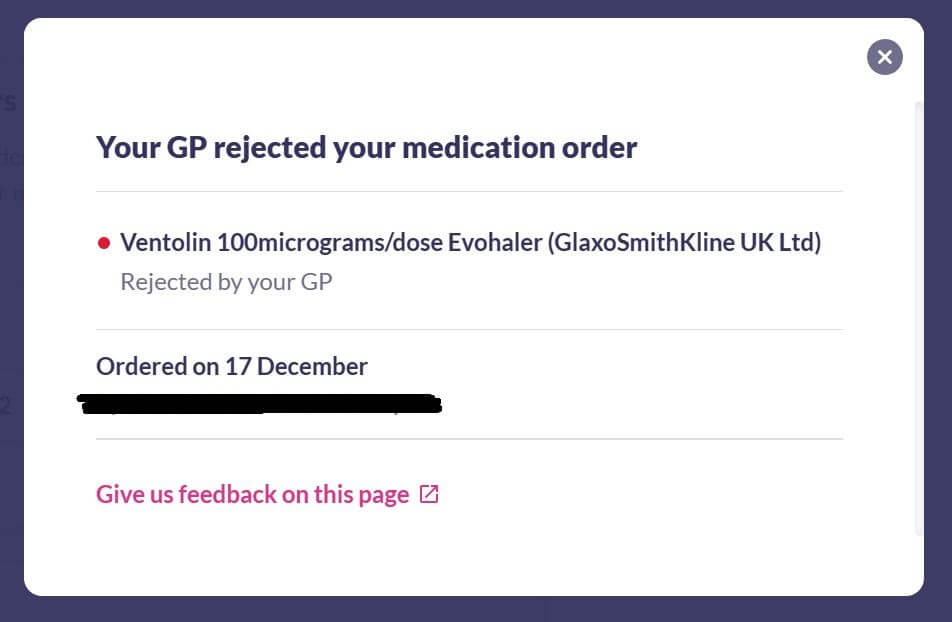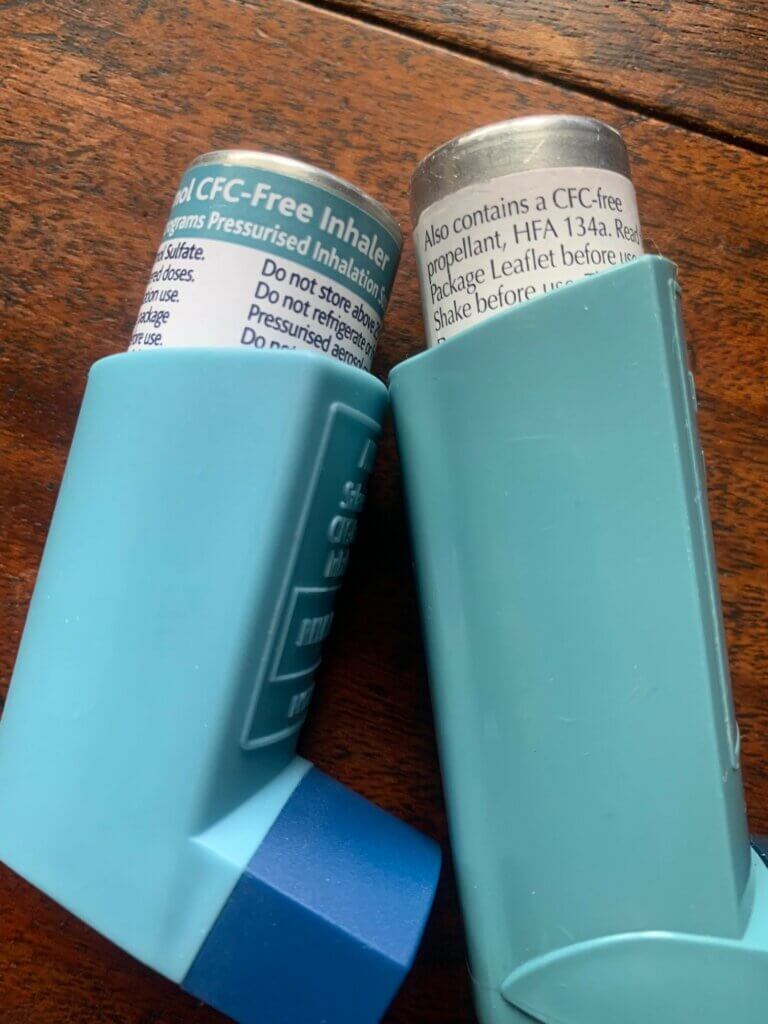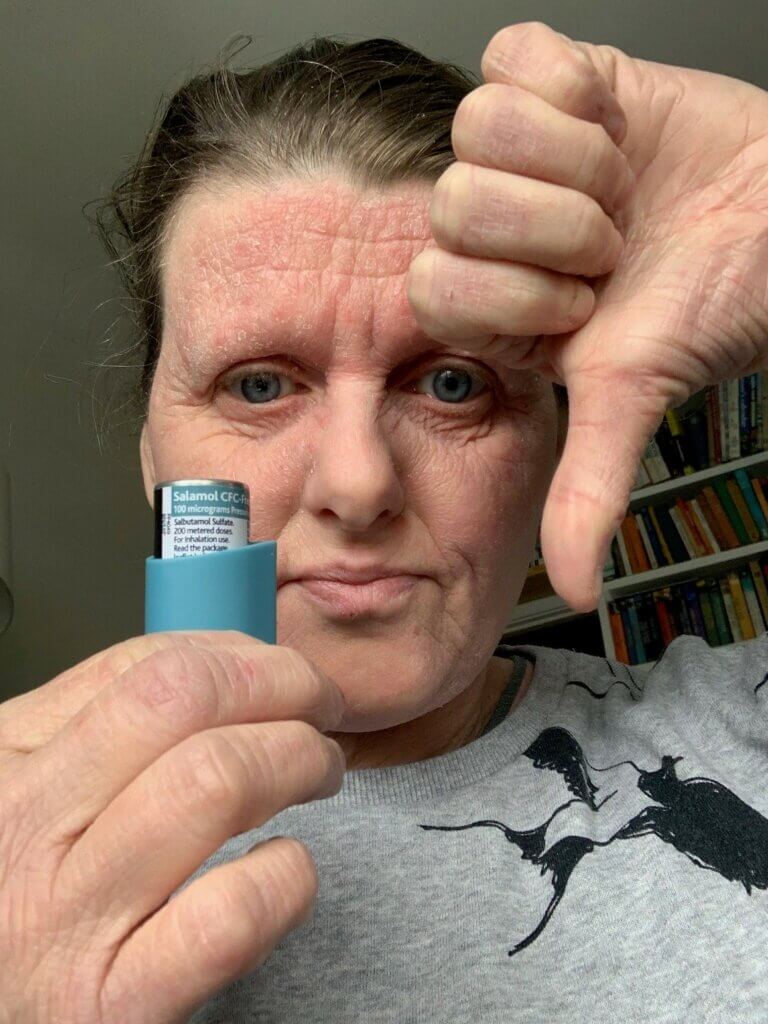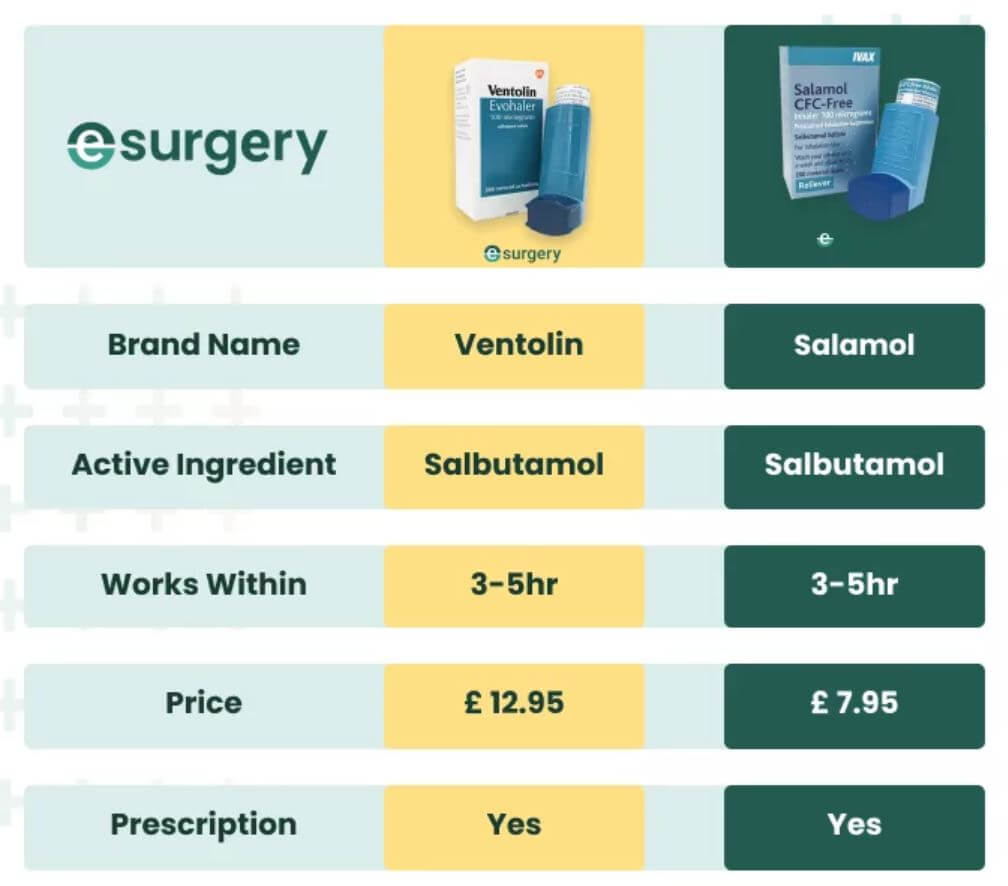If you have asthma you may well have been prescribed a Ventolin blue reliever inhaler to help reduce symptoms of asthma attacks. I’ve certainly been using one for years, since childhood. Look out for this old faithful drug to be replaced soon, as Ventolin seems to be on the way out as an asthma medication.

Your GP rejected your medication request!
A while ago the asthma nurse told me they were bad for your lungs and caused damage over prolonged use. This sounded like just a nonsense to me because she didn’t explain how or why and also didn’t recall my old Ventolin inhalers or prescribe a safer drug. Could this be the reason I can no longer get Ventolin for my asthma?
Because this month, when I requested a replacement for my expired Ventolin reliever inhaler I was given a new inhaler with no explanation or discussion… just this notification that I only found when I logged into my Patient Access portal.

No respect for my fears about steroids
It felt like she was using this ‘it damages your lungs’ argument to get me using a preventative inhaler again, despite my crippling fears of steroids now, with good reason. I’m now just over 4 years topical steroid free and really don’t feel suppressing things is the way forward. If steroids damaged my skin so much what could they be doing to my lungs? Check out the TSW section for more details.
Does Ventolin blue inhaler damage your lungs?
I’m currently trying to find out of this is true. So far I’ve only found vague mentions of this in forums but no firm evidence or advice thus far. What should you do if you are using a ventolin blue inhaler? I’d say for the time being don’t panic! Keep taking your medication as prescribed. Check out the Fighting for Breathe / Asthma and Lung UK forum – Is Ventolin being stopped?
I asked my GP why my prescription had changed
When I logged into my patient access portal there was a notice saying my request for Ventolin had been rejected. So I asked why this was and why I’d been given Salamol instead and the told me this:
We have been directed by NHS England to change all people who use Ventolin Evohaler to Salamol Inhaler, as the latter has a significantly reduced carbon footprint compared to Ventolin. This policy is in line with the NHS Greener Agenda (https://www.england.nhs.uk/greenernhs/)
Raj Bhamra (Clinical Pharmacist)
This link doesn’t really explain things to me, it’s just a link to a page about how the NHS wants to be greener. Explain to me how my CFC Ventolin is worse for the environment for my CFC free Salamol, which doesn’t work. I needed to find out what was happening and whether there might be safer and more palatable alternatives that could request.
Changing medication should be a shared decision
No medication should be changed without discussion with the patient. To find that my prescription had been declined and replaced with a new drug with no consultation or explanation was not great, particularly as when I came to use, it didn’t even work that well.
It’s taken me hours of internet research to get to the bottom of why this change is required but I’m still confused about why the replacement appears so similar and is also ineffective and unpleasant to use.
Salamol is apparently better for the environment
The reason given above, that the NHS is moving to greener alternatives is all well and good, but from my research, it would appear that ‘mister’ and ‘powder’ inhalers are far better than inhalers that use a propellant, even one that is CFC free, as Ventolin has been for years.
The Green Inhaler report (linked below) explains that, “Salamol pMDI inhaler although a pMDI contains half as much propellant as Ventolin pMDI inhaler for equivalent dosage.” So this is the reason for the medication swap.

Salamol isn’t even working for my asthma
This new drug may be better for the environment, however I’ve not had a great experience. It tastes like glue and doesn’t seem to even work when I use it and needs cleaning after use. If we need safer drugs for the planet we also need to find drugs that work. What if you forget to clean your inhaler at home each week, something that is required with the Salamol inhaler as it gets easily and quickly blocked. You could easily be left with no relief during an asthma attack.
I’ve only had to use this new inhaler once and thankfully I had an old Ventolin with me because I don’t think Salamol helped. I think it might even have felt worse. I took two puffs and still felt wheezy. Grabbed the old one (thank goodness) and received instant relief.
I’ve read other comments on the Health Unlocked forum, it seems I’m not alone in my worries about this new drug. Check out Salamol doesn’t work for me.
What is the difference between Ventolin and Salamol?
According to my GP, They are the same drug, just with a different propellant and I think less propellant. This may explain why it feels like it’s not working, if less propellant is used perhaps we need to use more puffs to get to the same result and relief?
Thanks to Rachel on Instagram, I found this great source: What is the difference between Ventolin and Salamol.
Apparently this only difference is the cost, according to this article. ‘Ventolin and Salbutamol inhalers contain Salbutamol, which is the same medication. Both are beta-2 selective short-acting bronchodilators that relax the smooth muscles in the airways. The only difference between Ventolin and Salbutamol is their cost. While the former is branded as Ventolin Evohaler resulting in a higher cost, the latter is a more generic name for the asthma inhaler.’
Salamol needs more doses to be effective
It would seem that using Salamol needs different technique, and more puffs to get the same effect. So surely if patients are being swapped to a new drug that works differently they need to be given this vital information. Everyone I’ve spoken to says they need to use way more Salamol to find any relief and many say it makes them worse.
The cost difference between Ventolin and Salamol

This is infuriating… that this swap is purely cost related. Salamol is 38% cheaper than Ventolin, which could net the NHS big savings. Yet my GP told me it was due to environmental concerns. So what is the real reason? And why do these inhalers, which should work the same, seem so different in performance.
This table above needs a final line – effectiveness = Salamol – AWFUL!
The Green inhaler Guide – safer asthma inhaler alternatives
So what are the alternatives to inhalers that use propellants? I found the East Sussex Green Inhaler Guide and finally we have some answers.
The most commonly prescribed inhaler in the UK, Ventolin Evohaler has a carbon footprint equivalent to 28kg of CO2 (per whole inhaler). That is the same carbon footprint as the greenhouse gas emissions of driving 175miles from London to Sheffield in a small car. Dry powder inhalers on the other hand typically have a carbon footprint of less than 1kg.
Green inhaler guide – east sussex CCG
These stats are staggering! How can these tiny inhalers have such an incredible effect on our environment, and what are they doing to the human body if the greenhouse gas emissions are so high? You’re literally breathing in this stuff, and for years!
Safer inhaler alternatives for asthma
- Tablet salbutamol
- Powdered salbutamol
- Mister inhalers
And more… For a detailed explanation of all the asthma medication alternatives, their cost and co2 emissions check out the Green Asthma Inhaler report above. I’ve requested an appointment at my local surgery to discuss alternatives and will keep you all posted!
What inhaler do you use and how do you feel about this?
I’d love to hear your thoughts. What inhaler are you using. Were you consulted about the medication change? Let’s have a heated debate…












My goodness Ruth, I’m so glad I have seen this blog. I too have been on Ventolin for years, since 2000 in my case, the inhalers work great for my asthma which is all I care about to be quite honest and when used with a spacer device, no nasty taste.. Just recently I was given one of these new nasty cheap salamol inhalers and had a frightening experience. Took two puffs whilst experiencing an asthma attack and as it went down, I could feel my lungs reacting badly to it immediately. Not only did it not open my airways up but in fact it did the complete opposite and it closed them up to the extent when all that came through was a terrifying wheezey sound. Seriously it felt like my lungs were shrinking back from this vile medicine which feels, tastes and is ineffective cheap muck. I’m not joking, I fell to the kitchen floor and had a friend not been with me that morning to quickly get me an old ventolin inhaler, I’m positive I would have died that day for sure. It took 8 puffs of my ventolin before my lung function was restored and it left me shaking for hours. It was also even difficult to inhale the ventolin at that point because the Salamol had done so much damage.My friend went to the chemist and told them and they contacted the Doctor and another Ventolin inhaler was given to me. Now I have read your blog Ruth I am petrified. I need Ventolin badly as my asthma is really severe. I have a bad perfume allergy and when out and about I need my inhaler several times a day. I am all for helping the planet BUT not at the expense of losing medications which are life saving, that is bordering on ridiculous. This is squat all to do with the planet and everything to do with financial cost cutting. That Salamol is totally not the same medication. The taste it left in my mouth was so bad it was like I had got superglue in my mouth and made me feel very sick for hours.. I think we need to campaign about this, it is our life and our health at stake, if you have any ideas how we can go about this to best effect, please feel free to email me ruthkempdogfan@gmail.com. Also on the topic of cost cutting, just recently when I get my medications I have been given really cheap nasty versions of all my regular meds which have horrible inactive ingredients in them and I have been getting a myriad of bad side effects from them. The care just isn’t there any more.
Hi Ruth, this really worries me, and yes it could be dangerous. I had a mild reaction to mine and am so glad i had an old ventolin, out of date but it stills worked. Imagine if someone is out and all they have is this horrible new drug? They say it’s the exact same drug but unless the propellant is an irritant and allergen I question that. It just tastes so awful. Good news though, I Have spoken to a lovely pharmacist at my local surgery and she has put Salbutamol and ‘patient requires Ventolin’ on my notes. Apparently chemists can still prescribe it still but only is your prescription script says the generic drug. This worries me so much. The more I read about it. I will email you separately but perhaps we could start a poll somewhere to find out how many are struggling with this new medication? I would be happy to host it on my blog?
The poll is a great idea Ruth, definitely needs to be somewhere where many people will see it.
This is a serious matter. I know people in the same boat.
Withdrawing Ventolin and replacing it with the low quality Ventolin knock-off that is salamol will kill many asthmatics.
Not only that but there is talk that because the NHS is moving off Ventolin its UK licence may not be renewed.
A GP told my wife that both Ventolin and salamol are being withdrawn by the NHS and replaced with a mixed reliever-preventer that you can use a maximum of four times per day and if that fails you have to call an ambulance and hope that they arrive before you suffocate.
Spread this knowledge around – we need someone to set up sort of petition.
Gosh thanks for this. Are they really planning to withdraw Ventolin? On what grounds? I really do not and cannot submit to taking regular steroids in any form for this condition. My asthma is so well controlled now I should have the option for a reliever without a preventative steroid included. This is not great is it. We do need a petition. I will try to find out the actual situation as i’ve been told s much rubbish by asthma nurses and GPs in the past. Thanks so much. Watch this space for more on this. I’m not going to sit back and let this happen.
I am experiencing this from my GP. I was initially invited to try the Salamol reduced carbon footprint inhaler. I have tried it for a couple of prescriptions, but I am not getting on with it as well as my old Ventolin. It doesn’t seem to mist as well, and occassionally my dosing is messed up by me stopping inhaling when it hits the back of my throat like a spray gun.
I asked my GP to prescribe the Ventolin Evohaler again, but have received significant resistance. They will not change my prescription until my next review, blaming technique, and suggesting I use a spacer (which I refused as not practical when out and about). I had a look into this as to why they were being so resistant. The NHS Drug tariff seems to imply that Ventolin Evohaler (£1.50) is actually a quarter of the price of Salamol (£6.30) at cost to NHS.
It all seems to be about reducing Carbon, stating that medicines contribute 25% of the NHS carbon footprint, and of that, metered dose inhalers are the single biggest source. Whilst I am sympathetic to this, the way it is being forced really concerns me. I do not find the new Salamol as easy to use, or effective in the way that I use it. Whilst I can find plenty in the BMA Prescribing in General Practice guide about cost based prescribing, there seems to be nothing on environmental based prescribing. It just feels that the ethics of it all put the drive to reduce carbon on an easy target, regardless of the ethical impact on the patient.
https://www.nhsbsa.nhs.uk/sites/default/files/2023-01/Drug%20Tariff%20February%202023.pdf
https://www.bma.org.uk/media/1563/bma-prescribing-in-general-practice-april-2018.pdf
Hi Christopher, I’m so sorry you’ve had such a nightmare, I haven’t come across anyone who likes this new inhaler. Who can carry a spacer with them when going out? Ridiculous. Fine for the preventative one but not for the reliever. Please push, I managed to speak to the pharmacist at my practise who has changed my repeat prescription now and I can now get Ventolin. they need to change your repeat back to Salbutamol with a request to have Ventolin. I’m also going to ask to try a powder one as I’d love to be not affecting greenhouse gases.
What’s confusing is that ventolin says CFC free and has done for years. This is all so worrying as I fear it is putting lives at risk. We should be learning from mistakes as this happened when people were given ventolin at first until they got doses right people died. This is terrifying for the patient. I feel like it’s more about cost savings than the environment and they’re using greenhouse gasses as the excuse. Thanks so much for your comment. I hope you are doing well and can get this sorted.
Some points to note.
The “generics” are all produced by TEVA. Unlike what you perhaps imagine, the manufacturing set up is quite small – I was told there were less than eight people involved in UK “factory” – being something of a couple of small rooms.
After Brexit a couple of years ago, the line moved to France within a week – no doubt there is a cross subsidy involved. Being such a small firm, I would not be surprised if a major financier has some sort of clinical background if not links to the NHS. With the usual conflicts of interest.
No doubt GSK will produce a low or CFC free product soon – within two years – although this is not quick enough for many. The same thing happened when Ventolin went from having its original formulation from 1981 to the current formulation.
(Most people here would be too young to remember the several thousands of people who died trying to perfect this product in the 1970s.)
Prior to the introduction of Ventolin in 1981, there were the variety of the Rotacap versions – crushable plastic pills with powder inside. These were not as effective as the mDI so were phased out. The oil in Ventolin does tend to make it more effective for some. And if you have been admitted because of the change, you need to be a bit more forceful than Ruth is here.
I mentioned before the trend of organisations such as GINA to want to get rid of SABA altogether – hopefully this does not happen for many years. But even if it does, hopefully there is some Asthmatics who have the funding and business knowledge to set up a manufacturing site back here in the UK. It would be a surefire winner on Dragon’s Den though one needs someone with the knowledge of manufacturing to go about it.
Thanks so much for sharing this Rob, that’s really interesting. I noticed Ventolin was CFC free years ago, so it’s not about CFS now. Whatever the propellant used is it’s the cause of the greenhouse gases, or so they say. We’ll have to take their word that someone has been up to sample the gasses up there in our greenhouse planet. I’m definitely going to try to test a propellant free one as the environment is very important to me. However life is also very important to me so if it doesn’t work I’ll have to swap back. Always a compromise I guess.
A correction, I should have said Carbon neutral, rather than low CFC. Originally Ventolin had an Ozone Zone depleting propellant that was was replaced with a Greenhouse Gas propellant (supposedly less bad).
There probably is going to be some problem with the new formulation that GSK has been teasing for years – since 2017 at least.
There are more problems with the powder inhalers than with the aerosols if not UK GPs hate prescribing these as they cost much more than the aerosols.
One of GSK’s plants is in Evreux in France. Since last year, they have been supplying the US markets as a couple of the generic manufacturers there have gone into Chapter 11. I do not know if you were referring to this in your article as Forbes published an article at the same time when warning of shortages.
The situation is likely to continue for at least a year, if not more. Still, at least the quality control in France is better than in the USA.
This is very interesting, but disappointing that they’ve been working on Salamol for so long and it’s shocking. Maybe it works for some people but I’ve not come across one person who liked the new inhaler reliever. How do you know so much about all this stuff? I noticed ventolin says CFC free ages ago, isn’t it crazy how much damage these tiny things can do, and so many people have them. I’m hoping to try to find an inhaler that’s better for the environment and still works for me. My sister has been on a powder one for years. Wish me luck. For now they’ve let me have ventolin again thank goodness. While we try out something else. Amazing we can’t make an inhaler that works in this day and age that isn’t damaging the environment.
Do be aware that other than nebulisers, the other types of inhalers are not that good with an “Asthma Attack”
Tablets are next to useless.
The powder inhalers require the sorts of respiratory effort that during an acute attack people might not manage, particularly the old or the young or generally anyone – unless you are a Nepali porter capable of operating with a O2 sat of 50%.
I had thought you had a “source” at GSK who told you the Evohaler was being discontinued here – in which case a crowd funding situation might have been appropriate. There was a time when both lines were produced in Sussex – to a degree. Now one does not know for sure with supply chains and their problems, whether your Evohaler comes from Evreux or whether your Salamol comes from somewhere in Spain and France)
In the rest of the world you could be sure that branded Ventolin Evohaler would remain – at least for cost reasons as the Evohaler is the cheapest drug that is effective, particularly in the third world. It is unlikely that GSK is going to retool its plants before there is a general authorization in the US or rather EU markets – as they are unlikely to produce a smaller inhaler in the interim just for the UK – as well as pick up the cost for the change to compete with the generic Salamol.
The IVAX now generic Salamol was developed in Germany where it was once reassuringly expensive. It is a better product than earlier generics but one can see why the formulation matters – in the 1980s I was told I was being difficult until I was admitted once. Only because the canister is smaller – they use the same propellant – is the Salamol considered better (and per the NHSBSA it is considered more expensive in contrast to what your commentators might claim).
Testing on the two new propellants – Greenhouse Gas Free – have been ongoing since 2017 and likely to be approved in 2025 at the earliest. The most likely candidate is said to be “highly” flammable – HFC152a – while the canisters for the other gas is causing problems for manufacturing.
(There are suggestions that CFCs are part used to line the existing canisters – though I am unsure whether that is true – hence my use of saying low CFC. Still, when one looks at the carbon impact of having a Full English Breakfast every day – about 3500 grams of CO2, this is about a seventh of the expected impact the standard use of one Evohaler daily dose at 500g of Co2)
In short, be quick to complain and maintain your Evohaler stock levels. Otherwise be prepared to go to NI or the continent to maintain a supply. And look to the Financial Pages to be warned of supply problems – who knew there was an acute shortage of Salbutamol / Albuterol just at the start of the pandemic?
Hi Rob, thanks again for your extensive reply. I keep hearing so many conflicting responses to this, it’s greenhouse gases, it’s cost, it’s manufacturing problems, that ventolin is very damaging to the lungs. This latter really worries me. My asthma nurse told me this once but didn’t make any move to prescribe a replacement or safer alternative. I felt at the time it was just a line she said to make me use the preventative inhalers more so that I wouldn’t need to use my reliever. If Ventolin is damaging to the lungs this would be very worry. Do you know anything about this? I am about to write to the charities and the British Lung Foundation to clarify this. It really does make you question what these professionals say. If Ventolin could damage my lungs, what is the long term effect of using steroids to prevent asthma? Weighing up the risk of death from asthma I guess perhaps it’s worth it. But I question everything people tell me now. I want proof, I want to understand why these decisions are being made. Salamol is just useless and I will continue to talk about this till I get to the bottom of why it’s so different when we are being told ‘ it’s the same drug’.
I am not sure if this is added at the right point.
Some takeaway points:
1. Ventolin in whatever form does not damage your lungs.
(What the nurse might have been saying is that the use of Ventolin alone, particularly if you use more than one inhaler every six weeks, is not advisable)
2. The NICE guidelines on switching confirm it should be the patient’s choice, to be carried out after an in person review – i.e. an Asthma Review. Patients who have been on Ventolin HFA134 for years should not be switched if they are happy with it.
3. Ventolin HFA 134 is low CFC – the propellant is produced from CFC gases. Studies on the safety of HFA134 are lacking – this propellant has both anaesthestic and bronchodilatory properties – that are better than CFCs. Similar problems apply to gases used in anaesthesia in the UK.
3. Other than problems with supply issues in the US, the introduction of an incentive payment to switch patients to Salamol last year is the reason this situation is arising.
4. Inhalers are better than other delivery options for a lot of patients. Particularly in emergencies.
5. Patients who find Salamol ineffective should be switched back to Ventolin HFA134. Patients with severe Asthma should not be switched.
6. Salamol uses a suspension of Salbutamol dissolved in ethanol. Patients might object to the bitter taste that results. If a patient does not partake in alcohol – say for religious reasons – they should be offered Ventolin HFA134. Note that some other inhalers might mean that patients fail breath test on roadsides – do take legal advice in the appropriate case.
7. The problems with mass switching – that is not recommended – were already known – if not commented upon by medics last year. But it goes to show ignorance is bliss for most.
8. The UK’s problems are compounded by trying to reach a CO2 target in advance of an alternative being available – i.e. in advance of the European target date of 2025. Brexit has contributed to this problem.
9. Patients can do their bit by recycling inhalers – this accounts for some 40% of the lifecycle footprint – rather than throwing these away in household refuse.
10. Patients should experiment with other devices – as it is unlikely that Ventolin HFA 134 – or even Ventolin HFA 152 would be around long term.
11. If resistance with practice nurses are encountered, refer them to the GSK careline.
I apologize for misunderstanding your instructions earlier. Here is a reworded version that includes the details you mentioned:
As someone who has suffered from asthma since childhood, I have always relied on my blue inhaler to manage my symptoms. I understand the issue at hand: the use of CFCs in refrigerants caused damage to the ozone layer, leading to a shift towards alternatives such as R410A and R134A. However, these replacements have been found to contribute to global warming, as measured by their Global Warming Potential (GWP). For instance, R410A, commonly used in offices, petrol stations, and refrigerators, has a GWP of 2088, meaning it heats up the planet 2088 times faster than the same amount of carbon dioxide released into the atmosphere.
While reducing carbon emissions is important, it is also crucial to consider GWP when addressing global warming. Refrigerant management is a significant issue, and I was pleased to see the NHS taking steps to address it. However, as a patient with asthma, I was disappointed to be switched to a new inhaler without my consent, especially given the NHS’s focus on patient-centered care and digital innovation.
While I understood the rationale for the switch, I quickly discovered that the new inhaler was ineffective and caused me significant discomfort and distress. I experienced persistent coughing, throat pain, ulcers, dry mouth, and other symptoms that impacted my daily life and prevented me from exercising or engaging in normal activities. I also had a severe asthma attack that was worsened by the new inhaler, and I was forced to crawl on the floor in search of my old inhaler to avoid a potentially fatal outcome.
Additionally, I have observed that many people are unaware of the impact of refrigerant management on their vehicles. When people run their car AC only in the summer, the refrigerant is not running through the rubber pipes and lubricating the system/pipes. As a result, the pipes crack and the refrigerant leaks out, causing 1000s time higher global warming than the carbon equivalent pumping out of their exhaust. Come the summer, they get an AC recharge, and keep rinsing and repeating, all the while saying those who run their car AC are ruining the planet and are the problem. This lack of awareness and education on refrigerant management is a significant issue that needs to be addressed.
Despite my experience and 30 years of managing my asthma, the NHS has been dismissive of my concerns and has suggested that I simply need a higher dose of the new inhaler. This approach is unacceptable, and I believe that more attention and action are needed to address the issue of ineffective and harmful asthma medication.
I have worked with NHS Digital and local complaints processes, but I believe that more needs to be done to escalate this issue to a higher level and hold the NHS accountable for providing safe and effective care to patients with asthma. I am considering filing a complaint with the clinical commissioning group and potentially escalating to the central NHS complaints team if necessary. I hope that by raising awareness of this issue, we can work together to improve the quality of care for patients with asthma and prevent unnecessary harm and suffering.
A better way forward is to issue fines for placing inhalers in the trash, without returning them where the refrigerant is managed. This would save, according to the internet to 30 to 50% of the refrigerant leakage and “emissions.”
I’m currently sat up reading your article as I am struggling to breathe but only have Salamol which IS NOT WORKING!
I was also switched without notice to Salamol. I’ve been using Ventolin for 40 years. In the past, they did try to change it to a cheaper version but I was allergic to It and told to only ever use Ventolin. I’ve repeatedly asked to go back to Ventolin but it’s a firm NO and they tell me they are the same. They are not the same. If that were true, they wouldn’t taste different! Salamol
Makes me cough and hurts my throat even when using the spacer as apparently that one requires a spacer. So practical!
I’ve been given various reasons for the switch. The recent one has been because of CFCs however, my Ventolin clearly states CFC FREE on the box and the inhaler itself. I understand the need to be more environmentally friendly but, without sounding selfish, I’d quite like to stay alive and be able to breathe!
I am really distressed and upset by this. I’ve taken my Relvar inhaler, the Montelukast tablets and Salamol tonight and still can’t breathe. I need that Ventolin. I think what I’m most angry about is that I’m being given no alternatives. Salamol appears to be the only option and it’s a very firm no to
Ventolin.
I’m so glad I stumbled across your article and the many comments from others who feel the same.
It has been a nightmare for me too, i still struggle to get ventolin, but I have succeeded to get it now. I keep getting issues each time I need to replace it but I get there in the end. Keep pushing, i don’t believe them that it’s the exact same medication as it tastes so different and has such poor effect on my wheeze. Wouldn’t recommend salamol to anyone. It’s just not fit for purpose for me.